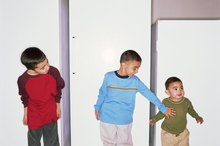What does fact checked mean?
At Healthfully, we strive to deliver objective content that is accurate and up-to-date. Our team periodically reviews articles in order to ensure content quality. The sources cited below consist of evidence from peer-reviewed journals, prominent medical organizations, academic associations, and government data.
The information contained on this site is for informational purposes only, and should not be used as a substitute for the advice of a professional health care provider. Please check with the appropriate physician regarding health questions and concerns. Although we strive to deliver accurate and up-to-date information, no guarantee to that effect is made.
Tips on Kids Putting in Contact Lenses
Contact lenses are recommended for some children to improve their vision. Along with maintaining proper hygiene, knowing how to insert contacts correctly is important for your child's vision and comfort. Putting contacts in might be challenging for your child until he has sufficient practice. With a few tips and techniques, the process can be made easier for both parent and child.
Do Not Blink
In “Are Contacts Hard to Put In?” Gary Heiting, OD says that if your child has trouble putting in contacts, it might be because he is blinking right before the lens touches the eye 1. The lens may fold or drop if he blinks before it makes contact with the cornea. To remedy this, Heiting advises practicing touching the white part of the eye without blinking. To do this, your child should first wash his hands thoroughly. Have him look in the mirror, open his eye widely and try to touch the white part of one eye with the soft pad of a fingertip without blinking. He should maintain the finger on the eye for a second or two before removing it. After practicing for a while, your child may find it easier to put in his contacts.
- In “Are Contacts Hard to Put In?” Gary Heiting, OD says that if your child has trouble putting in contacts, it might be because he is blinking right before the lens touches the eye 1.
Stay Calm
Convergence Insufficiency Exercises for Children
Learn More
Staying calm will help your child put contact lenses in her eye. A 2009 article from Thrive, Children's Hospital Boston's pediatric health blog, provides tips for parents with children needing contacts. The article mentions that if you as a parent exhibit nervous or anxious behavior during the contact lens application, your child will pick up on this and may resist putting in the contacts or resist letting you put them in her eyes. Get your child in a good mood with toys and play until they are ready. If you will be putting the contacts in for her, get your child involved in the process. Have her hold the lenses or hold one part of her eyelid open while you hold the other.
- Staying calm will help your child put contact lenses in her eye.
- The article mentions that if you as a parent exhibit nervous or anxious behavior during the contact lens application, your child will pick up on this and may resist putting in the contacts or resist letting you put them in her eyes.
Test for Inverted Lens
An inverted contact lens will be difficult to put it on and will produce discomfort. The Cleveland Clinic's Cole Eye Institute states you can train your child to identify an inverted lens by one of two methods. The first is to have him place the lens on his forefinger and examine the edges. If the edges appear straight up or curled in, the lens is in the correct orientation. If the edges appear to flare or curl out, the lens is inverted and should be flipped inside out. The second method involves pinching the lens between two fingers. If the lens curls and folds in on itself, it is in the correct position. If it flips out and sticks to his fingers, it is inside out.
- An inverted contact lens will be difficult to put it on and will produce discomfort.
- If the edges appear to flare or curl out, the lens is inverted and should be flipped inside out.
Related Articles
References
- All About Vision: Are Contacts Hard to Put In?
- Thrive: One Mother’s Story: Help, My Babies Need Contact Lenses
- Clevland Clinic: Soft Contact Lenses
- The Cleveland Clinic. Contact lenses.
- Vision Service Plan. Contact lens exams are not the same as routine eye exams.
- Tom Nugent, Staywell Custom Communications. "Don't Skip Your Contact Lens Exam." Dec.2005 VSP.com
Writer Bio
Roger Perez has been a freelance writer since 2003. He focuses on fitness, nutrition and lifestyle articles, with his work appearing on LIVESTRONG.COM. He also writes for Homeschool Building Blocks, a website for home-schooled children. As a martial artist since 1989, Perez has deep respect for the human body. He holds an Associate of Arts in pre-law from Daytona State College.









